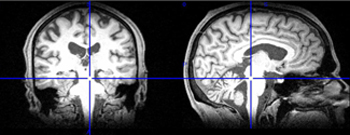Training your brain to beat the pain: new hope for chronic sufferers
Release Date 18 July 2014

A new study by a University of Reading researcher has found that painful areas on our body can be controlled through the power of positive thinking.
In a study led by Dr Tim Salomons, healthy participants were given five minute spells of cognitive behavioural therapy¹ (CBT) prior to having eight, hour-long sessions of heat applied to their forearm to evoke pain. This created areas of secondary hyperalgesia - a measure of pain sensitivity in the area surrounding injuries such as burns.
By managing their negative thoughts the group managed to reduce the physical symptoms of secondary hyperalgesia by nearly 40%. Secondary hyperalgesia is an example of central sensitisation, where pain sensitivity is enhanced by the central nervous system.
Although not a replacement for other forms of treatment the results are good news for those who suffer from chronic pain condition like lower back pain and fibromyalgia, as central sensitisation has been observed in chronic pain disorders.
CBT focuses on examining negative beliefs and changing thoughts that are distorted and unhelpful. Used widely to treat mental health issues and ‘emotional' pain, this research showed that CBT can actually alter the body's physical responses to pain after injury.
Dr Salomons, from the University of Reading's School of Psychology and Clinical Languages, conducted the work at the Toronto Western Research Institute during his previous role at the University of Toronto. He said: "Chronic pain is a debilitating and common complaint. Over five million people in the United Kingdom develop chronic pain each year². British businesses are estimated to lose 4.9 million days to employee absenteeism through work related back pain³.
"Of the 34 participants given secondary hyperalgesia, half were trained to control negative thoughts related to the pain by, the other half was given training unrelated to the pain stimuli. We then examined the groups' secondary hyperalgesia. The results were striking. The 'pain-trained' group achieved a 38% reduction in secondary hyperalgesia, while the control group reported an increase of just 8%.
"We know that pain feels more debilitating when it signals illness or injury compared to when we are undertaking an activity we feel is beneficial - we go through the pain barrier. However we didn't know whether our beliefs simply changed the emotional response to pain or if the mind actually changed sensations that arise from the body - until now."
The study also showed we can reduce our emotional response to a painful stimulus, such as the fear we feel before being injected with a needle.
"The trained group also reduced the ‘unpleasantness' they were feeling during the eight sessions by 58%," continued Dr Salomons. This indicates that the training changed the emotional response to pain as well as the sensitivity of the skin around the burn."
Dr Salomons believes that the accessibility of this type of training would allow individuals who suffer from enhanced pain sensitivity to practice pain reducing techniques in their own time.
"The CBT instruction was adapted almost entirely from a commonly available manual. ‘At-home' cognitive treatments, working in tandem with other treatments, could make a difference to NHS finances and waiting times as well improving the lives of chronic pain sufferers."
Dr Salomons conducted this research at the Toronto Western Research Institute in conjunction with Dr Karen Davis. The paper was published online this week in the journal Pain.
ENDS
Notes for Editors
¹Cognitive behavioural therapy is a talking therapy that can helps manage problems by changing the way we think and behave. It helps manage problems in positive way, encouraging patients to examine how their actions can affect how they think and feel. Unlike other types of talking treatments, such as psychotherapy, CBT deals with your current problems, rather than focusing on issues from the past. It looks for practical ways to improve a state of mind on a daily basis.
² http://www.nationalpainaudit.org/media/files/NationalPainAudit-2012.pdf
³ http://www.britishpainsociety.org/media_faq.htm
The University of Reading is listed among the top 1% of universities in the world (THE World University Rankings 2014)
The University's School of Psychology and Clinical Language Sciences is a world leader in teaching, research and training. The international research standing of the School is based on a world class contribution to psychology and neuroscience in a number of areas, with the bridge between neuroscience and clinical disorders being a common theme to much of its work. The School comprises the Department of Psychology, the Department of Clinical Language Sciences, the Charlie Waller Institute and the Centre for Integrative Neuroscience and Neurodynamics.
